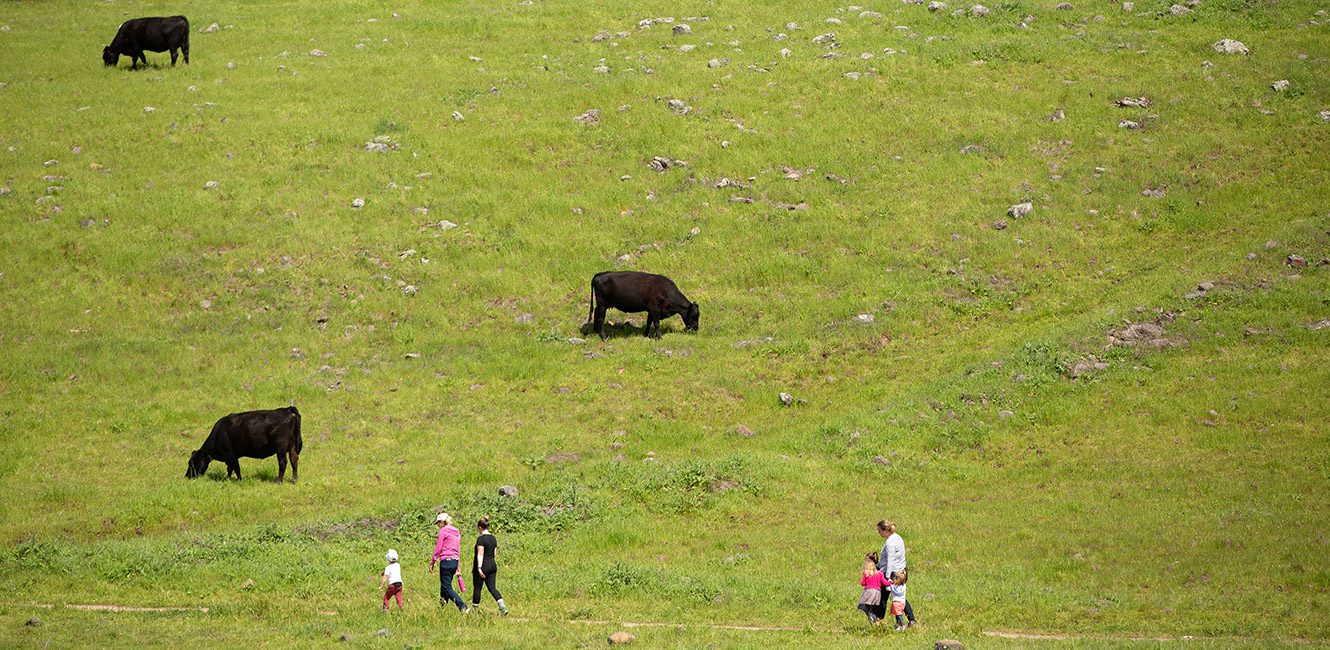Grazing in Sonoma County Regional Parks

Throughout history and prehistory, California’s grasslands evolved with grazers such as bison, elk and antelope. These animals kept grasslands healthy by mowing grasses back during their feeding, loosening thatch with their hooves, and fertilizing and reseeding the land with their manure.
Although the animals are different today, grazing remains an important conservation tool for land managers. Working with local livestock producers, Sonoma County Regional Parks currently utilizes grazing in some form in 10 of our public parks. Each park has its own “grazing regime” depending on the conditions and needs of that location.
Among the Regional Parks locations where grazing is utilized, Helen Putnam, Laguna de Santa Rosa Trail, Foothill, Cloverdale, Gualala, and Maxwell regional parks use rotating herds of sheep and goats on a seasonal basis to accomplish specific vegetation management goals. Taylor Mountain, Crane Creek, North Sonoma Mountain and Tolay Lake use cattle (cows). Mark West, which is not yet open to the public, also uses cattle. Most of the grazing is seasonal.
Benefits of Grazing
Grazing must be done carefully and strategically. Grassland ecosystems do poorly when they have too little disturbance, but they also do poorly when they have too much. Every site is different, depending on its topography and other conditions, which is why grazing requires constant tailoring, monitoring and modification to succeed.
When done properly, grazing keeps grasslands and ecosystems healthy in a number of ways. Grazers can cultivate grasslands through their normal activity while helping keep invasive plant species in check. This results in more native habitat that in turn allows other native species, including wildflowers, butterflies, birds and other wildlife, to thrive.
By reducing fuels, grazing makes our landscapes more fire-resistant and fire-resilient. Healthier grasslands are also more permeable, leading to better groundwater recharge — important for dealing with both flooding and drought. In addition, the stronger vegetation resulting from grazing sequesters more carbon, helping to curb climate change and its effects.
Safety Precautions
As part of our commitment to promoting local agriculture, Sonoma County Regional Parks contracts with professional shepherds and cowherds who use time-honored methods for managing their grazers. Sheep and goats are typically contained within temporary fencing, meaning park visitors are unlikely to come into direct contact with them. Cattle, by contrast, have a larger range inside the parks and often share space with park visitors.
Sheep and Goats
Here are some tips to keep in mind when encountering sheep and goats inside their paddocks:
- Don’t touch the fence. The temporary fencing used to contain sheep and goats is electrified, so don’t get too close.
- Don’t touch the animals. Please do not attempt to go inside the grazing paddocks or to feed, pet or handle the animals.
- Keep dogs on leash. There is often a livestock guardian dog on duty to protect the sheep and goats from predators; please be mindful and keep all dogs leashed and under control.
Cattle
We ask that all park visitors use common sense when walking or riding among cattle. Although these are large animals, they are not naturally aggressive and there’s no reason to fear them. The first and best advice is simply to give them room. Here are some other tips to keep in mind when encountering cattle:
- Watch your step. Cows leave manure, and especially during the rainy season trails can be muddy and hazardous.
- Don't startle them. Keep your distance and walk around cattle, stepping off the trail whenever necessary.
- Avoid calves. Cattle are protective of their young, so don't get between a calf and its mother, and don't try to touch them. If you see a stray calf, just leave it alone.
- Keep dogs on leash. Cattle may become agitated when a dog approaches. Always keep your pet fully leashed and under control, and try to prevent it from frightening cattle or any other animals.
- Respect fences. Never climb over or under, or cut through, a cattle fence. Only cross fencelines at gates. (Please close pedestrian gates behind you, and leave larger vehicle gates as you find them, either open or closed.)
- Keep us informed. Please report any animals that are acting sick, injured or aggressive to the nearest Regional Parks staff. If possible, note the number on the animal’s ear tag. Do not approach the animal.


 Translate
Translate